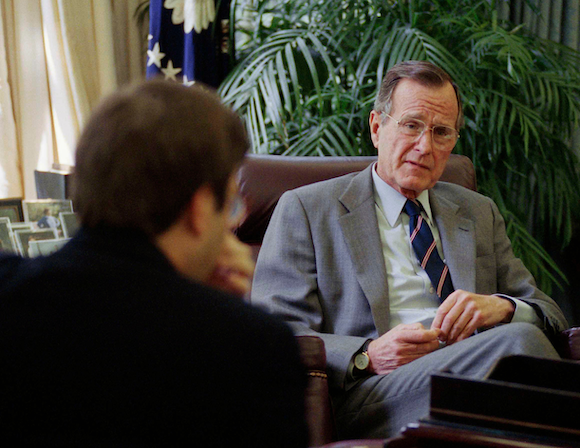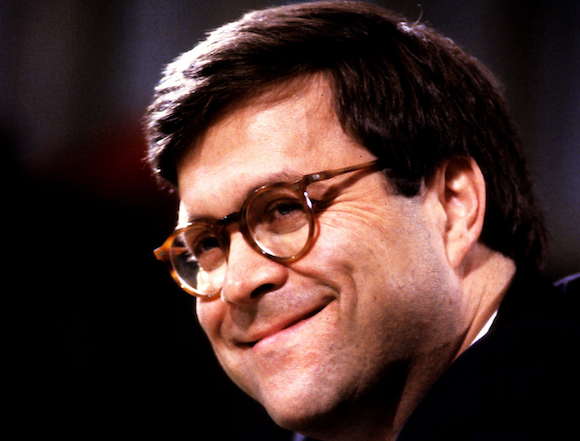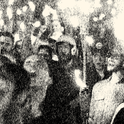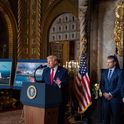If the lawlessness of the Trump years can be reduced to a single moment, it might well have occurred on 1st June. Six days after the police killing of George Floyd, the president decided to stage a photo opportunity by holding up a Bible in front of St John’s Episcopal Church, across from the White House. At the time, protesters against police brutality were still on the square near the church. Trump’s photo-op required their removal. “What ensued was a burst of violence unlike any seen in the shadow of the White House in generations,” the New York Times reported:
As he prepared for his surprise march to the church, Mr Trump first went before cameras in the Rose Garden to declare himself “your president of law and order” but also “an ally of all peaceful protesters,” even as peaceful protesters just a block away and clergy members on the church patio were routed by smoke and flash grenades and some form of chemical spray deployed by shield-bearing riot officers and mounted police.
The combined state force also included secret service agents, park police, guards brought in from the Federal Bureau of Prisons, helicopter flyovers and other tactical personnel.
Trump didn’t make his “surprise march” alone. At his side were Defense Secretary Mark Esper and the head of the Joint Chiefs of Staff, General Mark Milley, who was dressed in full combat fatigues. The image it projected was not of confident strength or the assertion of “law and order” but of a petty despot’s rogue aggression against American citizens. General James Mattis, Trump’s former defense secretary who had steadfastly maintained his silence since resigning in December 2018, finally spoke up. “I have watched this week’s unfolding events, angry and appalled,” Mattis declared. “When I joined the military, some 50 years ago, I swore an oath to support and defend the Constitution. Never did I dream that troops taking that same oath would be ordered under any circumstance to violate the Constitutional rights of their fellow citizens.” Even the still-serving Milley made a remorseful apology.
When the tear gas cleared, and the country absorbed the magnitude of what had happened—a violent attack on peace-abiding Americans by their government—the search began, inevitably, for the brains behind this ugly show of brute power. They were soon enough found. The administration official who had ordered the infiltration of Lafayette Park, with orders to “flood the zone,” deploying “the maximum amount of law enforcement out on the street,” was the nation’s top law enforcement official: United States Attorney General William P Barr.
This discovery was ominous, even frightening. Since the birth of the modern civil rights movement in the 1950s, the Justice Department, with its staff of over 100,000—including the the FBI, the Drug Enforcement Administration and the Civil Rights Division—has led federal efforts to redress the historic wrongs of slavery and its aftermath by ensuring full citizenship and equal rights for African Americans. It was the Justice Department that moved to put an end to lynch mob justice after the brutal murder of 14-year-old Emmett Till in 1955; that forced open whites-only universities in the Deep South and drafted the legislation that ultimately led to the landmark Civil Rights and Voting Rights Acts in the 1960s.
“His Justice Department is an instrument for suppressing civil rights protests”
Now, under Barr, the Justice Department has become the federal government’s instrument for suppressing a civil rights protest, and the example was being followed elsewhere. As of mid-June, demonstrators had been tear-gassed in more than 100 cities across the land.
At first Barr claimed ignorance—always the safest route in Trumpworld, though when a crisis comes, the exit gets crowded. It did this time too, beginning with Trump. “The White House has placed the decision on Barr’s shoulders amid ongoing fallout,” CNN reported on its website. Soon enough even the Trumpists’ own favourite law expert Jonathan Turley, a professor at George Washington University and the lone scholar who testified on Trump’s side during the impeachment hearings, said: “If Attorney General Barr cleared that area for the purpose of the photo op, I would immediately call for him to step down, because that would be an outrageous abuse of power.”
Barr, meanwhile, was giving not one inch. On the Sunday morning TV programme Face the Nation, he maintained that the reports were exaggerated, pointing out that no “tear gas” had been used on the demonstrators, only pepper spray which “is not a chemical irritant.” In fact it is a chemical irritant and a type of tear gas, says the government’s own last-word authority on the subject, the Centers for Disease Control and Prevention.
If any of this made Barr anxious, he did not show it. His public face (or mask) throughout this crisis—and many preceding it since his appointment as attorney general in February 2019—has been one of steady calm and quiet ferocity of purpose. Unlike Vice President Mike Pence and Secretary of State Mike Pompeo, both of whom appear to secretly despise the president yet nonetheless abjectly serve his whims and caprices like flunkies from the age of Nero or Caligula, Barr seems neither pliable nor weak. “Those who think he’s a tool of Donald Trump are missing the point,” explained one friend to the New York Times Magazine. “What Trump gives Bill Barr is a canvas upon which to paint. Bill has longstanding views about how society should be organised, which can now be manifested and acted upon to a degree that they never could have before.” And yet as Barr’s notoriety grows, outside his immediate circle, the nature of these guiding principles are little appreciated.
When Barr, who is 70, agreed to become Trump’s attorney general, some were surprised. Barr didn’t need the job. He had already held it once before, at the very young age of 41, under the first president George Bush and in what now seems a golden age of responsible governance. After leaving government, Barr got rich doing corporation work and law. In 2008, he retired early with a $28m package. Neither is Barr unfulfilled in his “civilian” life. He has a close family—a wife and three grown up daughters (all lawyers). When the youngest, Meg, had recurrent Non-Hodgkin lymphoma at age 27 and “faced a roughly 20 per cent chance of survival,” Barr “stopped working and focused on his daughter’s care,” according to David Rohde of the New Yorker, one of the few to have studied Barr’s career closely. “After Meg underwent chemotherapy and a stem-cell transplant, Barr rented a house in the town of Scituate, outside Boston, so that Meg could be isolated from other patients and avoid infection. They read books, walked on the beach together, and talked about what Meg would do if she survived.”
And indeed, Barr is sociable beyond the family too, being personable, cultured and well read. “His annual holiday parties, traditional Scottish cèilidhs with music and singers, drew hundreds whose friendships he had maintained over the years,” wrote another Barr watcher, Mattathias Schwartz of the New York Times Magazine. “He wrote and sold a screenplay about World War II. He spent time traveling abroad and hunting birds.”
“Barr was hired with the all-but-explicit promise to mitigate or neutralise the much-anticipated Mueller Report”
Barr did not join the early Trump insurgency. He has a history of donating to mainstream Republicans like John McCain and Mitt Romney. In 2016, Barr did give $2,700 to Trump’s campaign, but that’s a negligible sum for a rich Republican—he also gave $50,000 to one of Jeb Bush’s political action committees.
Barr, then, is not a card-carrying Trumpist, but he arrived in the camp knowing this made no difference. He had only to consider the case of the man he replaced, Jeff Sessions, who was the first national politician to support Trump yet now holds the distinction—in a crowded field—of being perhaps the single most humiliated of all his ex-appointees. Sessions incurred Trump’s wrath by adhering to standard lawyerly protocol, and recusing himself from Robert Mueller’s investigation of Russia’s meddling in the 2016 election. Trump supposed, with some reason, that the investigation helped explain the loss of the Republican majority in the House in 2018. The day after the midterms, Trump fired him. And the Democrats, with their majority, eventually impeached Trump.

At the Senate confirmation hearings all cabinet officials must sit for, Barr was asked how he would deal with the Mueller investigation, which would now fall under his supervision. He said: “I have known Bob Mueller personally and professionally for 30 years. We worked closely together throughout my previous tenure at the Department of Justice under President Bush. We’ve been friends since.”
This answer deftly played to the senators’ self-flattering idea of themselves as a gentleman’s club—in which friendship becomes code for gentlemanly conduct, which transcends grubby partisanship. It also sidestepped the fact—known to one and all, including those same senators—that long before his nomination, Barr had on his own instigation drafted a memo sent to the Justice Department saying, in effect, that Mueller’s investigation was invalid by definition. The argument, such as it was, started with the observation that its origin lay in the firing of James Comey, the director of the FBI and the first to begin exploring the murky passages of Trump’s Russia connections. But Trump’s prerogatives as president, the Barr logic went on, included firing anyone who works for him, including the FBI director. And for Mueller to challenge this “would do lasting damage to the Presidency and to the administration of law within the Executive branch.”
Thus did Barr, nominated to become the highest law enforcement official in the land, all but state his intention to embark on a one-man insurgency to expand “presidential supremacy” to its furthest possible horizon. This is in defiance of the US Constitution, which places strict limits on the presidency and invests greater power in Congress, including the power to oversee the presidency. In phlegmatic, bookish, intellectual Barr, then, the rogue president has found his ideal enabler.
Trump is still most comfortable with New Yorkers, most of them self-made, rough-edged, “brash,” often Jews like the real estate developer Stanley Chera, whose death from Covid-19 in April, aged 78, Trump genuinely mourned. Barr, who is also from New York, is a different type. He grew up closer to the city’s cultural life. His father, another Donald as it happens, was for years the headmaster of Dalton, an elite Manhattan private school. Bill’s mother Mary taught at Columbia University and was an editor at Redbook, the most literary of the period’s “women’s magazines.”
“Barr has the best chance of getting Trump a second term—it will require him to sabotage our election system”
Yet Barr has some things in common with Trump’s mentor and dream lawyer, the notorious Roy Cohn, sidekick to the infamous 1950s Red-baiter Senator Joseph McCarthy and consigliere to mobsters. Like Cohn, Barr was educated at Horace Mann, the competitive prep school for ambitious high-achievers and then went to Columbia. Like Cohn—and like Trump, for that matter—Barr was an outsider in an insiders’ world.
Trump grew up in the “outer borough” of Queens, a “bridge and tunnel” away from glittering Manhattan. The Barrs were Catholic conservatives on Riverside Drive, an uptown enclave of writers and professors in a world dominated by progressives. Today the most startling fact about Donald Barr’s years at Dalton was the hiring of a young maths teacher named Jeffrey Epstein—yes, that one. But at the time Donald Barr’s reputation was for being “autocratic, insular, and obsessed with adherence to rules” in swinging Manhattan, and unhappy parents pushed him out in the early 1970s.
In the same period, Bill Barr himself was an undergraduate at Columbia, a left-wing campus alive with anti-Vietnam protest and clashes over the college’s slumlord presence in its neighbourhood, Morningside Heights. Barr proudly belonged to its small faction of conservatives. He wanted to go help fight the Cold War. His father had been with the Office of Strategic Services in the Second World War. Barr joined its successor, the CIA, in the mid-1970s. It was the lowest point in agency history. Long years of illegalities—“Black Ops,” including assassinations and domestic surveillance—had been exposed and come under congressional investigation. “I don’t want to be quoted as saying they were not excessive,” Barr recently told the New York Times. “There were some that clearly were excessive.”
But in his mind, and to many others in intelligence, the trouble wasn’t the excesses. The CIA was doing its best to fight communism and win the Cold War. The trouble was the oversight, the exposure and “body blows.” The CIA was an instrument of foreign policy for presidents from Eisenhower on, often their best way of fighting the Cold War. They should be left alone to use it as they saw fit. After he got his law degree at George Washington University, Barr began his career working for presidents, first Reagan and then Bush Sr, in the years when Republicans easily won three straight presidential elections, in part by promising to restore the power of an office that had been diminished by Watergate.
Conservative intellectuals of the 1980s promoted the concept of the “unitary executive,” which argues that the president is the sole leader of the entire executive branch. A generation later, it is the basis of the memo Barr wrote saying Trump was free to fire Comey, and Mueller had no authority to investigate him.

It was on the back of that paper that Barr was hired with the all-but-explicit promise to mitigate or neutralise the much-anticipated Mueller Report. In doing so, he showed great political skill. Rather than standing on the platform of the “unitary executive”—an argument most Americans had not heard of and would not understand even with patient explanation—Barr instead out-manoeuvred Mueller, seizing on the Special Counsel’s conscientious deferral to Congress on the matter of Trump’s potential impeachment as an admission that the investigation turned up very little incriminating evidence. It wasn’t true, as Barr well knew, and as Mueller privately objected. But it was too late. Trump charged through the opening Barr had given him and said the report amounted to a “complete and total exoneration.” Whether or not Americans believed this, they heard it; all the many other claims and counter-claims that followed descended into noise.
This act and others—wanton firings of respected Justice Department officials, defiance of congressional subpoenas, ignoring court orders, misleading statements like those about tear gas—have invited contempt from leading conservative jurists like Harvard’s Charles Fried. “His reputation is gone,” said Fried. “His principal concern is power,” and so he has become “the apologist for perhaps the most dishonest person to ever sit in the White House.” Some 2,000 former Justice Department officials, many of them former prosecutors, have signed letters calling for Barr’s resignation. As he wields his ideological paintbrush, Barr seems not to care or notice.
So what exactly does he want? One theory is that he has deep-seated reverence for the presidency. But as the New Yorker’s Rohde points out, his “position on executive power wavered over time, depending on which party controlled the White House.” Barr advanced no arguments in support of the Democratic presidents Clinton and Obama when they came under attack from Republican legislators. It is not presidential power, then, but Republican presidential power, which Barr seeks to protect under any assault or even challenge.
If presidential power is camouflage, what lies beneath it? Barr himself gave a remarkably revealing answer in a speech at Notre Dame University last year. “We must be vigilant to resist efforts by the forces of secularisation to drive religious viewpoints from the public square,” Barr said, “and to impinge upon the free exercise of our faith.” The speech mentions the devil words “secular” and variants—“militant secularists,” “secular orthodoxy,” “the new secular religion”—21 times. And what is it the militant secularists intend with their religion? They “call on the State to mitigate the social costs of personal misconduct and irresponsibility,” insist the answer to “growing illegitimacy is not sexual responsibility, but abortion,” that the solution “to drug addiction is safe injection sites,” that “the solution to the breakdown of the family is for the State to set itself up as the ersatz husband for single mothers and the ersatz father to their children.” On top of this “the call comes for more and more social programmes to deal with the wreckage.”
“Every time Trump breaks the law, he enrages the enemy in Barr’s higher combat—the ‘militant secularists’”
Trump knows victory in November depends on two things: making sure his base turns out on election day, and doing his level best to keep the Democrats—who are the majority, especially among the young—from voting. Trump can handle the first assignment, riling up his supporters through divisive rhetoric. His best weapon in achieving the second, though, is Barr’s Justice Department.
Barr has joined Trump in trying to discredit mail-in balloting, favoured by many states to protect the health of voters. If unable to vote remotely, many may stay home rather than risk Covid-19 infection by standing in long lines. This is what Republicans want. Trump in his usual manner has been recycling falsehoods about postal voter fraud—the same claim he made in 2016 but which was thoroughly discredited.
There have been irregularities in voting, but to the extent the system is rigged it has been done through restrictions enacted by Republicans in as many as 20 states—through voter identification laws, restrictions on early voting, limited polling hours and more—whose fully intended effect has been to disenfranchise poorer people and people of colour.
In earlier times the Justice Department could be counted on to make the strongest possible case for universal enfranchisement. But recent Republican presidents, from Reagan on, have steadily undermined the department’s civil rights division, and by ordering the attack on the Washington protesters, Barr has shown how much further he is willing to go.
The second effort Barr can be expected to make will be more directly against Trump’s opponent Joe Biden, who has a solid lead in polls, including in critical battleground states. If Biden continues to lead through the summer, Barr could orchestrate an “October surprise”—a sudden investigation, perhaps, of Biden’s son Hunter and his business dealings in Ukraine (a red herring raised by Republicans during impeachment). Barr has already test-launched another missile, a counter-Mueller investigation seeking to show the original Russia investigation was an attempt to “sabotage the presidency of Donald Trump.” Here the idea will be to implicate Obama and with him Biden.
Why go to these lengths for Donald Trump? The answer is the same one that has drawn conservative intellectuals like Barr to disrupters and rabble-rousers for many years. In the 1950s it was McCarthy; in the late 1960s it was Nixon’s vice president Spiro Agnew, who attacked “the effete corps of impudent snobs”; in 2008 it was the “hockey mom” and defender of the “real America” Sarah Palin; now it is Trump. Each offered the frisson of violating the “norms” and “rules” that keep conservatives from winding the clock back and restoring the nation to what they see as its previous, better condition. Trump himself may be an irreligious libertine. But he is the means, not the end—the “blunt instrument for us,” as his first Svengali Steve Bannon said in 2016.
Four years later Barr—in some ways a conventional ultra-conservative, in sharp contrast with Bannon’s post-modern economic and ethnic populism—seems to believe the same thing. Every time Trump breaks the law, violates another ethical standard, rips another tear in the social fabric—every time he retweets a follower shouting “white power”—he enrages and offends the real enemy, the “militant secularists” against whom Barr is locked in the truer, higher combat. The blunt instrument can be indulged when he breaks bones and shatters glass, perhaps needs to do this to satisfy his own urges. It may even be welcome if those “excesses” further frustrate the other side.
“The most feared, criticised and effective member of Trump’s Cabinet,” as Rohde has said, Barr also has the best chance of getting Trump a second term—better than Trump himself. It will require him to sabotage our election system. But if doing so means a major victory against the demons of secularism, it will be worth it to Bill Barr.













